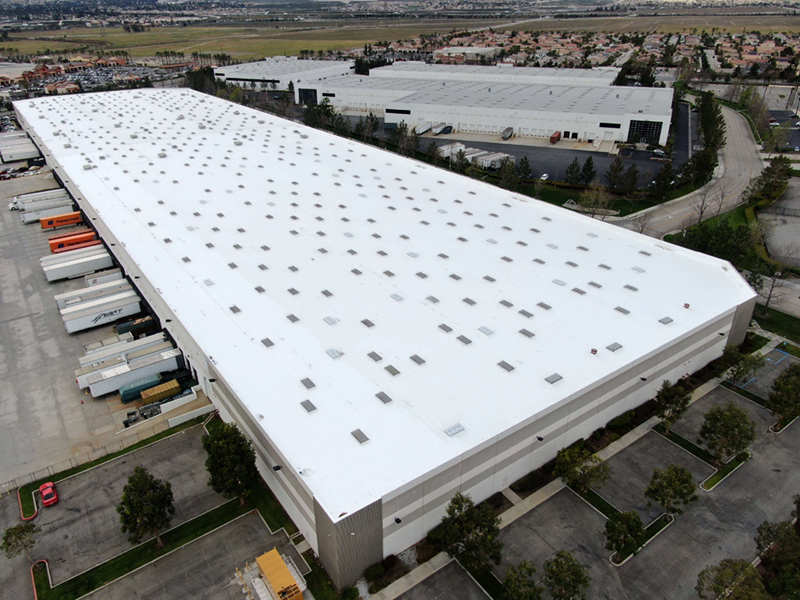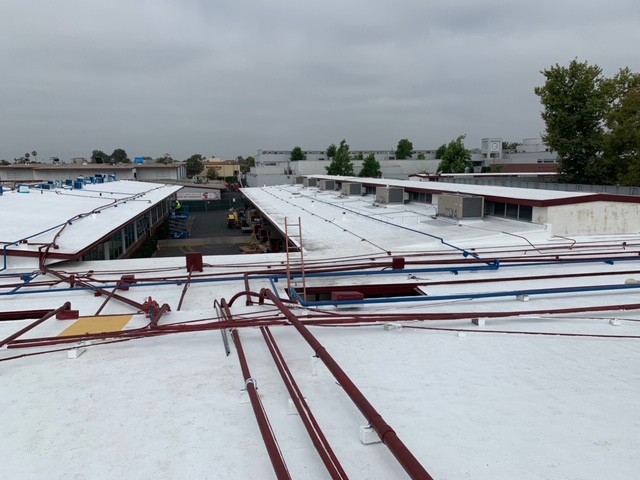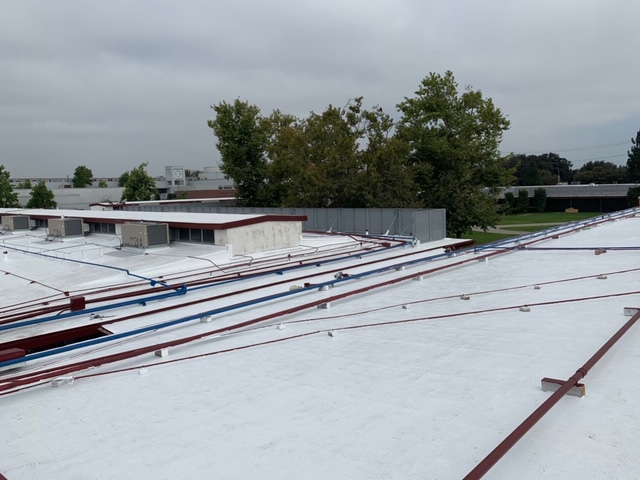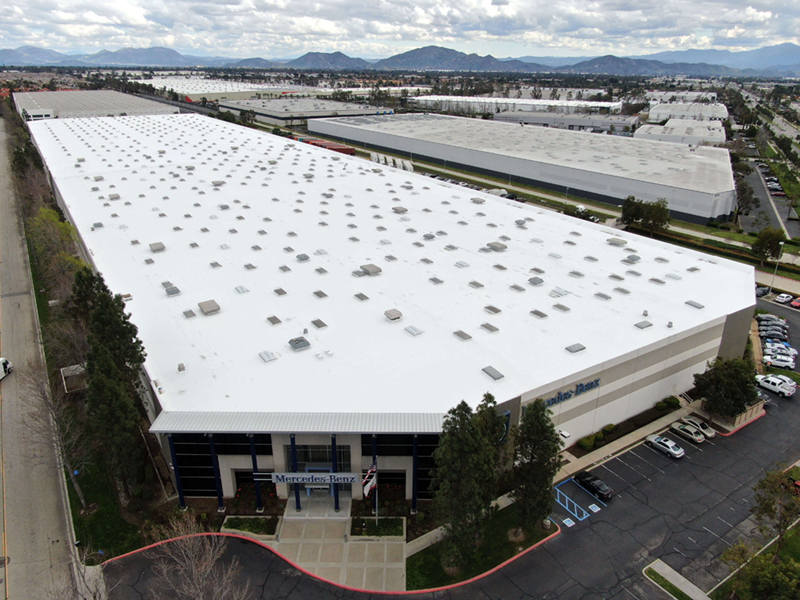Restoring Your Roof with Coatings Systems: Benefits & Considerations

If your building’s roof system is aging or demonstrating signs of wear, you might be considering whether you can get by with repairs or whether it’s time to install a new roof. However, there is a third alternative between roof repair and roof replacement — restoring your roof with a roof coating system.
Roof restoration offers many advantages that basic repairs can’t accomplish, and restoration is an excellent way to extend the life of your commercial roofing as a more affordable option to replacement.
Roof Restoration Versus Roof Replacement
What is the difference between restoring your roof versus replacing it, and when is one more preferred than the other? Roof replacement involves a tear-off of virtually all existing roofing materials from the roof deck and installing all-new materials, effectively restarting your roof’s life cycle. Roof restoration, by contrast, utilizes a roof coating system to reinforce and enhance the existing roof, restoring the roof to like-new status and extending its life span in the process.
There are times when a full roof replacement is the only viable option — for example, if the roof is already past its life expectancy, has endured extensive damage, displays multiple roof leaks across a wide area, has sustained internal moisture from ponding water, etc. However, there are many cases in which a roof restoration can solve existing issues and keep new ones from arising; without the need for a full replacement.
Advantages and Benefits of Roof Restoration
Why should you, as a building owner, consider roof restoration? Let’s discuss several key benefits of doing so:

More economical than a replacement
Restoring a roof costs considerably less money than a full replacement and provides more overall value for the dollar.
Extends the life of the roof significantly
A properly applied roof coating can extend your existing roof’s life span for 10-20 years depending on the system specified. When you consider that the average life expectancy for commercial roofing systems is about 20 years, you’re effectively increasing the life cycle by at least 50 percent.
Energy savings
By applying a “cool roof” coating, you can give your existing roof more reflectivity to UV rays, helping keep interior temperatures lower and your energy costs down.

More environmentally friendly
Replacing a roof sends tons of waste material into the landfills. Restoring the roof maintains the current materials and is considered a “greener” option.
Tax savings benefits
Replacing a roof comes out of capital expenses; restoring a roof is categorized as a maintenance expense, reducing your tax liability. In addition, since the government expects you to depreciate the roof over 39 years, you gain more from that benefit by extending the roof’s service life through restoration. You should always consult your tax professional during the decision-making process to maximize the total tax implications of your decision.
Less disruptive
Noise can be disruptive to your business (and any other businesses operating in your building). Roof replacement is both noisy and time-consuming; roof restoration is quieter and faster, resulting in less disruption.
Overview of the Roof Restoration Process
The specific processes used in restoring commercial roofing will vary slightly depending on the type of roof itself. However, the general steps remain the same. Let’s walk through the basic procedure.
1. Pressure Cleaning
The roof surface needs to be free of dirt and debris before restoration can take place. Your roofing contractor will accomplish this with a high-pressure cleaning of the entire roof of your building, followed by cleaning out of any blockages in the gutter systems.
2. Repair and Repointing
Next, the contractor will inspect the roof for damage and conduct spot repairs of damaged areas on the roof. This process may include repointing of broken metal or brick, repairing damaged seams on metal roofs, fixing cracks or vulnerable spots in the roof membrane, etc. The goal is to make sure the roof is entirely sound before the coatings are applied.
3. Applying a Sealer Coat
The next step is to apply a sealing undercoat to the existing roofing materials. This step seals and strengthens the roof, adding waterproofing and resistance to damage from the natural elements.
4. Applying the Top Coat
After sealing the roof, the contractor applies the top coat, which adds another layer of protection and makes your restored roof system look brand new. Top coats are typically applied in two layers, and they come in many varieties, including elastomeric coating, acrylic coating, and silicone coating.
5. Final Inspection
To finish the restoration project, the roofing contractor will conduct a thorough inspection of the work completed to ensure the coating was applied properly and that there are no areas of vulnerability. A good contractor will also provide a generous warranty on materials and workmanship.
Common Commercial Roof Types that Benefit from Roof Coating Systems
The roof coating and restoration process works primarily on commercial buildings with flat or low-slope roofs, typically with a membrane applied. Roof restoration can be an effective roofing solution for the following common roof types, among others:

TPO roofing: A popular synthetic single-ply membrane roof system used on flat roofs, valued for its durability, reflective capabilities, and fire resistance.
EPDM roofing: Short for ethylene propylene diene terpolymer, EPDM is a synthetic rubber single-ply membrane roof mainly used on low-slope commercial roofs.
PVC roofing: Used on both flat and low-slope roofs, PVC is popular for its fire resistance as well as its cooling properties.
Asphalt Built Up Roofing systems
APP and SBS Modified Asphalt Roofing systems
Working with a Manufacturer Representative Company for Roof Restoration Projects
Since every building is different, and every roof type has different needs and demands, choosing the best roofing products for a roof restoration can be confusing. When you work with a manufacturer representative like RoofSource, you have the advantage of our vast understanding of the roofing industry and the best products for every situation.
We evaluate your roof type, your needs, and your budget, and we make recommendations that will best suit your situation. And because we only partner with the most reputable brands in the industry, you can have confidence that you’re getting the best possible roofing solution for your needs.
Contact RoofSource today to learn more about how we can help.
